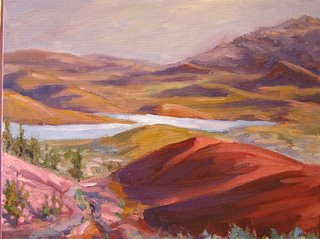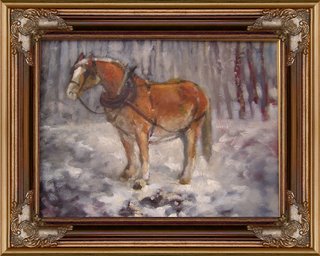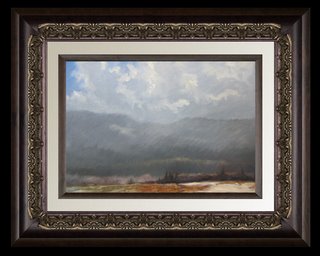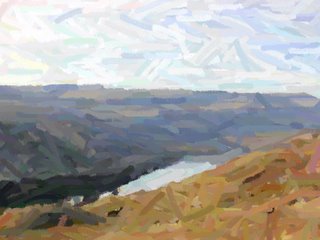This is a very important revelation to me on the subject of the 'biology of seeing' in the book, 'Vision and Art' by Margaret Livingstone. What becomes apparent to me is that the animal kingdom does not see color and sees the 'where' and not the 'what' of something. I shall be aware of this and see what it suggests with my horses. Makes sense. Even more so, expands the possibilities of my art work and why I paint like I do.
Margaret Livingstone, "Vision and Art" the biology of seeing.
Throughout the ages, artists have discovered emprically much about how the eyes see and how the brain perceives images. The earliest known cave-paintings, for example, are effective because our brains fill in the details around a simple line drawing. As observed by Margaret Livingstone, professor of neurobiology at Harvard University, "Artists have been studying how we see a lot longer than us neurobiologists. The disciplines of art and science converge at the biology of vision."
What may come as a surprise is that the visual system does not simply transmit a fully formed image to the brain, the way a camera might capture an image. Light from an image travels into the eye and strikes the retina, where it activates the rod and cone photoreceptors that convert light into a signal to be sent via retinal neurons to the brain.
"The function of the visual system is information processing, not image transmission," said Livingston, reminding the audience, "There is nobody up there to look at an image."
A key to understanding how we see was the discovery that the visual system is optimized to perceive sharp contrasts in the amount of light coming from an image, while ignoring subtle changes in light, which are usually less biologically relevant. Retinal neurons are patterned in what is known as "center-surround organization." The neurons fire when light hits the center of the cell's visual field but firing is inhibited when light hits the surrounding portion of the field. The center-surround effect optimizes the visual system to detect discontinuities, or edges. "Essentially, center-surround cells convert an image into a line drawing," said Livingstone.
Artists have developed techniques that take advantage of our preference for contrasts to give paintings a three-dimensional appearance. Before the Renaissance period, painters often used luminance in a piecemeal manner across the painting. Leonardo da Vinci and others of his period realized that they could enhance the illusion of depth by placing dark colors next to hues with high luminance. Luminance (also called "value") describes how much light comes from an object, and when high-luminance colors such as yellow are placed next to low-luminance colors such as dark blue, they create a strong contrast that the visual system interprets as a change in depth. The center-surround effect is also responsible for the optical illusion that colors look different depending on the color of their surroundings.
Artists have known for a very long time that color and luminance can be treated in an artistic sense quite independently. Picasso said, "Colors are only symbols. Reality is to be found in luminance alone."
Claude Monet. Impression, Sunrise (1873). Musée Marmottan, Paris. Monet's sun has equal luminance with the background.
Click to enlarge.
It is possible to have a color contrast that has no luminance contrast. One artist to explore this effect is Monet. In his painting Impression, Sunrise, the sun is quite bright and shimmers in a peculiar way. Livingstone measured the luminance and found that there is no luminance contrast between the sun and the background, yet you would expect there to be one because in real life the sun is quite a lot brighter than its surroundings. "It is this use of equal luminance that gives the sun its very peculiar and fascinating quality."
The what and where systems
The visual system can be divided into two areas that are distinct both in location and function. One pathway, located in the temporal lobe of the brain, is responsible for face and object recognition. It tells you what you are looking for, so it is sometimes called the "What" system. This part of our visual system is evolutionarily recent and common to primates only, said Livingstone.
The other major subdivision of the visual system is located in the dorsal region of the brain, and it processes motion, depth perception, spatial organization, and figureground segregation. This part of the visual system is evolutionarily older, and we share it with other mammals. Neuroscientists call this the "Where" system.
The What and Where systems of the brain.
Click to enlarge.
The evolutionarily old part of your visual system—the Where part—gets its input from the evolutionarily old parts of your retina, which are not sensitive to color. "There is a whole subdivision of your visual system that is color blind," said Livingstone. Luminance is interpreted by this color-blind part, so color is not required to see luminance differences. Nor is color necessary to see depth. Depth can be created using shading, perspective, figureground segregation, and luminance contrast, but color is not required.
Luminance is one of the primary cues that make you realize you are looking a a three-dimensional object.
Luminance is one of the primary cues that make you realize you are looking at a three-dimensional object rather than a flat picture. In his paintings of the Rouen Cathedral, Monet used luminance to achieve the effect of depth. Shadow or shading is an important cue as well, but the color of the shading doesn't matter. In Matisse's
The Woman with a Hat, the shape of the face is to be found in luminance alone.
Moving pictures
The ability to see motion is carried by the color-blind part of your visual system too, said Livingstone. Inducing a sense of motion in a painting is something quite powerful, and artists have been painting things that move for centuries. While some artists became experts at catching the body angle and musculature of people engaged in action, these paintings can look strangely static compared to some of the Impressionists' works depicting movement. Monet achieved the effect of motion by using black, blue, white, and yellow patches in his water. The black and white are higher contrast than the yellow and blue, which introduces a timing difference in your visual system that is interpreted in brain as motion.
Akiyoshi Kitaoka, Rotating Snakes (2003). This picture by psychologist Akiyoshi Kitaoka appears to move due to the luminance contrast between the black, blue, white, and yellow.
Click to enlarge.
Livingstone's research on dyslexia has revealed that dyslexic people have trouble with the timing of the Where subdivision of the visual system. To people with dyslexia, text looks like as if it is jumping about on the page. Dyslexics also have trouble discerning motion, depth, spatial organization, and figureground segregation. "The symptoms of dyslexia are similar to those of people who are cross-eyed." Dyslexic people also are often very talented artistically.
In living color
It may come as a surprise that the color system (a subdivision of the What system) is comparatively low-resolution. The color processing cells in the brain have rather large receptive fields. Because each cell can fire off just one signal at a time to the brain, overall there are fewer signals and thus lower acuity. Because your color resolution is so low, your visual system doesn't use color to define contours, it just lets color spread until it hits a border. Or as Livingstone put it, "Artists figured this out long before neurophysiologists—you do not have to color inside the lines."
The television industry took advantage of this low resolution when it created color TV. Because color images did not need to be as high in resolution as black-and-white images, broadcasters could fit both color and black-and-white signals into the segment of the broadcast spectrum allotted to them by the Federal Communications Commission (FCC).
Out of focus
Our central vision has high acuity, but our peripheral vision has lower acuity. Our peripheral vision is slightly out of focus, a fact we don't notice because we shift our gaze several times a second. Livingstone thinks low peripheral acuity may explain the Mona Lisa's enigmatic smile. Her expression seems to change depending on whether you look at her eyes or her mouth. Livingstone believes this is because as you look at her eyes, her mouth seems to smile more than it does when you look directly at it. "You see her smiling almost behind your back; when you try to catch her smiling, she stops," said Livingstone.
Click to enlarge.
In the slide above, filters have been applied to make the painting look as if it had been viewed by the peripheral, near peripheral vision, and central vision. The Mona Lisa looks like she is smiling more in the image generated by the peripheral vision.
This low-resolution trick is employed in photomosaics such as those created by the American photorealist Chuck Close. Your low-resolution peripheral vision helps you piece the entire portrait together. As you move your eyes around one of Close's canvases, you notice that different parts pop in and out of high resolution. "This is another way in which artists have figured out how to get a dynamic quality from a static image, said Livingstone."
Stereopsis
Artists can also make more realistic images by taking advantage of stereopsis, the perception of depth generated by the natural horizontal offset between the two eyes. The visual system uses the offset between the eyes to calculate depth, along with other cues, including perspective, shading, occlusion, and relative motion.
Even a painting with all these cues can look flat if it lacks stereoptic clues. These clues can be added, as the painters of the Impressionist era seemed to realize. "The Impressionists said they could paint the air," said Livingstone. "And I think they did that using false stereo cues."
A remarkably high proportion of famous artists have eyes that are not lined up, limiting their ability to see depth.
Some artists lack the ability to see stereopsis, a trait which may help them capture the world on a flat canvas. Gustav Klimt, for example, could not see three-dimensionally because his eyes were misaligned. "If your eyes are not lined up, you cannot see stereopsis because the connections from the two eyes don't end up in the same part of the brain," said Livingstone.
Livingstone reviewed the portraits of famous artists and found that many, including
Rembrandt, appear to have had misaligned eyes. "A remarkably high proportion of famous artists have eyes that are clearly not lined up."
Artists clearly have a head start over biologists when it comes to understanding many aspects of how we see. As biologists learn more about the biology of vision, artists may uncover a new trove of techniques for creating compelling and realistic images






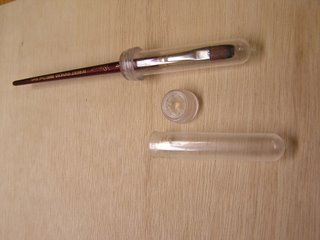










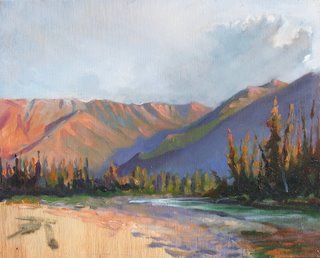




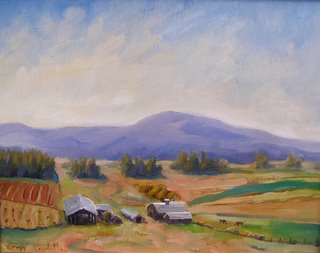



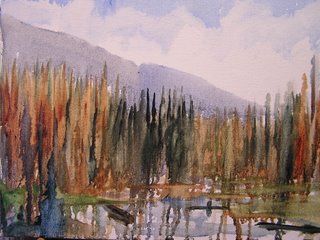
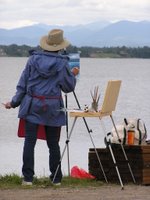

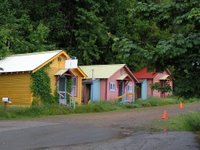

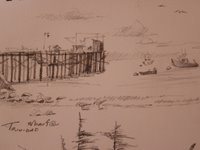

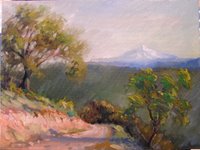
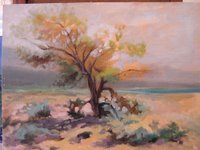
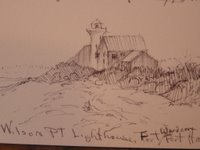 Wilson Pt., Lighthouse is on the elbow of the Olympic Penninsula, Wa where the Strait of Juan de Fuca turns south to become Puget Sound. I was at Port Hadlock for meetings of the Washington PUD Association. I managed to carve out some time early one morning to do some drawing and painting. I did a lot of drawing and watercolors on this trip to Lake Tahoe where I had another meeting of the Northwest Public Power Association. Me and my friend Betts took the long way down and back.
Wilson Pt., Lighthouse is on the elbow of the Olympic Penninsula, Wa where the Strait of Juan de Fuca turns south to become Puget Sound. I was at Port Hadlock for meetings of the Washington PUD Association. I managed to carve out some time early one morning to do some drawing and painting. I did a lot of drawing and watercolors on this trip to Lake Tahoe where I had another meeting of the Northwest Public Power Association. Me and my friend Betts took the long way down and back.

